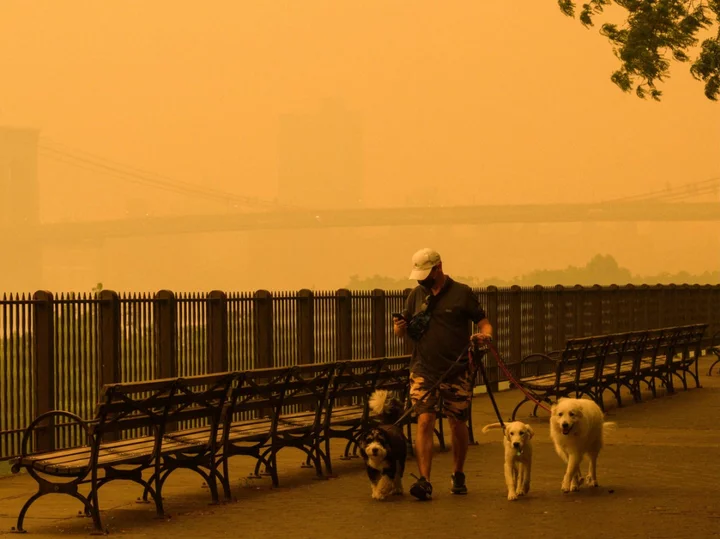
How to protect pets from wildfire smoke amid air quality alert
New York City and much of the tri-state area has been blanketed by smoke caused by raging wildfires in Canada. The poor air conditions have continued to spread throughout the northeastern United States. On Wednesday (7 June), New York City was ranked number one for the worst air quality in the world, with the Air Quality Index (AQI) at 342 and air pollution levels described as “hazardous”. Many officials have since advised people to limit their time outdoors and wear masks to protect themselves from the smoke. Public schools have also cancelled outdoor activities, including recess and gym classes. Follow for live air quality alert updates. Experts estimate that each hour of exposure to wildfire smoke is equivalent to smoking cigarettes continuously for the same amount of time, but that’s just for humans. Imagine how wildfire smoke affects our beloved pets? In fact, poor air quality may pose an even greater risk to animals because of their much smaller size. Here’s how to protect your pets from wildfire smoke as air quality alerts continue throughout New York. The biggest danger to pets comes from the fine particles found in air pollutants, which can get into the lungs and cause a variety of health issues – like eye irritation or respiratory problems. Some of the most vulnerable pets are older animals suffering from heart or lung disease. Certain breeds, such as pugs and bulldogs, may be especially at risk of inhaling too much smoke, according to the American Kennel Club. There are several signs that indicate a pet may be having problems from poor air quality. According to the US Environmental Protection Agency (EPA), some of the symptoms include coughing or gagging (particularly in cats), red or watery eyes, inflammation of the throat or mouth, trouble breathing, fatigue or weakness, and reduced appetite or thirst. The first thing pet owners should do at the sign of wildfire smoke exposure is to call their veterinarian. In the meantime, saturating a cotton ball with lukewarm water and squeezing it over an animal’s eyes can help with irritation and flush them out. In order to protect pets from wildfire smoke, try to reduce their exposure as much as possible. For outdoor pets like horses or livestock, bring these animals into a room with good ventilation, such as a utility room or garage. The EPA also states that smoke is especially tough on pet birds because of the construction of their respiratory systems. Birds that are exposed to too much smoke may act lethargic or struggle to breathe, and may sit in the bottom of their cages. Keeping the indoor air clean can also help protect animals against wildfire smoke. Pet owners should keep their windows closed and their pets in a room with an air purifier. Activities such as frying foods, burning candles, or using a fireplace can also be bad for pets because it adds air pollutants to your home. If necessary, pet owners take short potty breaks with their dog or cat before returning inside. It’s probably not best to go on a long run with an animal when air quality alerts are in effect, either. Read More Air quality – live: New York hits record pollution as Canada wildfire smoke shuts airports and risks millions From masks to AC units: All the dos and don’ts to keep safe from wildfire smoke New York air pollution spikes to hazardous ratings as wildfire smoke plagues East Coast From masks to AC units: All the dos and don’ts to keep safe from wildfire smoke ‘Fearful’ Shannen Doherty reveals her cancer has spread to her brain Fitness fanatic, 26, diagnosed with stage 4 cancer after feeling dizzy
1970-01-01 08:00

From masks to AC units: All the dos and don’ts to keep safe from wildfire smoke
New York City and large parts of the tri-state area have been placed under Code Red air quality alerts as smoke from wildfires in Canada continue to create hazy skies. The city is currently ranked fifth for the worst air quality in the world, following Toronto, Hanoi, Dhaka and New Delhi, as the Air Quality Index on Wednesday reached “unhealthy” levels across New York and other major US cities. The poor air quality is a result of more than 400 wildfires raging in Canada, leading to mass evacuations in the province of Quebec. Meanwhile, schools in New York City and Washington DC have cancelled outdoor activities such as recess and gym. As the wildfires continue to rage on, air quality in New York is expected to get worse later Wednesday afternoon, according to forecasters. But amidst an ongoing climate crisis, many climate scientists warn that wildfires could become more frequent and intense. Many officials have urged people to limit their time outdoors and wear masks to protect themselves from the smoke. In fact, wildfire smoke carries a number of pollutants that can pose a number of risks and hazardous effects. Here’s a list of dos and don’ts to help keep yourself safe during the Code Red air quality alert. Wear a mask If the Covid-19 taught us anything, it’s that masks help keep us safe from getting sick. The same goes for wildfire smoke. Masks can protect you from deadly air pollutants found in wildfire smoke such as fine particulate matter, also known as PM 2.5. But not all masks are created equal. While surgical masks work fine in protecting your lungs from the smoke, the most preferred method of protection are N95 or KN95 masks. Both N95 and KN95 masks work by fitting tightly to the face and filtering air using multiple layers of material, which are designed to trap extremely small particles. Stay indoors, or take precaution if you need to go outside New York City Mayor Eric Adams told New Yorkers in a statement to “limit outdoor activity to the greatest extent possible.” In addition to masking up, people should also avoid performing strenuous activities outside – such as exercising or biking – and change their clothes once they return home. Air purifiers vs air conditioners Outdoor air, including fine particles from wildfire smoke, can also enter your home through open windows, vents, or window air conditioning units. The Environmental Protection Agency (EPA) recommends using a portable air purifier to help improve indoor air quality. Indoor fans can also be used to help circulate air. The EPA also states that central AC systems, in which air is cooled and distributed through ducts, are safe to use during air quality alerts. “If you have an HVAC system with a fresh air intake, set the system to recirculate mode, or close the outdoor intake damper,” the agency said. As for window AC units, the EPA warns against running the portable AC during “smoky conditions because it can result in more smoke being brought inside.” Take steps to save energy and reduce pollution New Yorkers are encouraged to avoid activities that could create more fine particles indoors, such as smoking cigarettes; spraying aerosol products; using gas, propane or wood-burning stoves and furnaces; frying or broiling food; and burning candles or incense. The New York State Department of Environmental Conservation also recommends closing the blinds or shades to preserve cooled air, and limiting use of household appliances. Follow for live air quality alert updates. Read More Air quality – live: New York under Code Red alert and kids banned from outside play over Canada wildfire smoke Wildfire smoke tracker: Where the air pollution is headed next NYC and DC public schools cancel outdoor activities as wildfire smoke plagues East Coast As Pride Month begins: 5 LGBTQ+ icons who have helped shape pop culture and history Al Pacino, 83, expecting his fourth child with 29-year-old girlfriend Pest control expert weighs in on viral blue sofa debate
1970-01-01 08:00

4 Ways to Stay Safe When Wildfire Smoke Causes Poor Air Quality
Canadian wildfires have caused air quality alerts to go into effect across the U.S. Here’s how to stay safe.
1970-01-01 08:00

Explainer-What are the health risks from wildfire smoke?
By Nancy Lapid The northeastern United States is blanketed under a pungent haze caused by smoke carried down
1970-01-01 08:00

Want Cleaner Air at Home? You Can Get One of Amazon’s Best Air Purifiers on Sale for 40 Percent Off
Want cleaner air at home? You can get a Winix air purifier for 40 percent off right now on Amazon.
1970-01-01 08:00

Pope Francis to have abdominal surgery on Wednesday - Vatican
VATICAN CITY (Reuters) -Pope Francis, 86, will have surgery on his abdomen on Wednesday afternoon at Rome's Gemelli hospital, the
1970-01-01 08:00

EU approves its first vaccine for common respiratory virus RSV
By Natalie Grover and Eva Mathews (Reuters) -European regulators have approved the region's first vaccine for respiratory syncytial virus (RSV),
1970-01-01 08:00

How to react kindly to people with Tourette’s – and what not to say
Although most people have heard of Tourette’s Syndrome, they often wrongly think it’s a rare condition that always involves involuntary swearing. But the reality of Tourette’s Syndrome (TS) is that it’s a complex, inherited neurological condition which only features involuntary swearing (coprolalia) in 10-20% of cases, and isn’t as rare as you might think – more than 300,000 children and adults live with it in the UK, according to the charity Tourettes Action. And a number of celebrities have opened up about their Tourette’s, including Lewis Capaldi, whose shoulder twitches because of the condition, and Billie Eilish, who has said she experiences tics like clicking her jaw and tensing her arm muscles. On Tourette’s Awareness Day (June 7), which takes place during Tourette’s Awareness Month (May 15-June 15), Tourettes Action wants to raise awareness that rather than involuntary swearing, the key features of TS are tics. These are involuntary and uncontrollable sounds and movements which can range from limb and head jerking, whistling, grinding teeth and clenching the jaw, to legs freezing, or involuntary jumping. Many people with the condition will also have co-occurring features and conditions such as attention deficit hyperactivity disorder (ADHD), obsessive compulsive disorder (OCD), and anxiety. Also many experience pain because of their tics, often caused by repetitive involuntary actions such as hitting themselves, chewing the inside of their mouth, etc. During the awareness day and month, Tourettes Action is running the #ItsWhatMakesMeTic campaign in a bid to destigmatise Tourette’s by educating people and showing them the reality of living with the condition. “Research tells us that many people will experience discrimination because of their Tourette’s, and 75% of people will actively conceal their condition for fear of discrimination and people’s reactions towards them,” says Emma McNally, CEO of Tourettes Action. “People with Tourette’s often feel isolated and excluded because the level of awareness in society is so low.” One of the many things that can make life difficult for people with TS is the way others react to their tics, and McNally explains: “We also hear many people don’t know what they should say or how they should act towards someone with Tourette’s. It’s our goal to change that. We want to use Tourette’s Awareness Month to help raise awareness of the condition, to stop the stigma and enable people who live with Tourette’s to be fully included in society.” Here, McNally outlines the best ways for people to react when someone with Tourette’s tics… 1. Remember what comes out of their mouth isn’t what they’re thinkingAlthough 80-90% of people with TS don’t have involuntary verbal tics that make them swear or say inappropriate things, McNally stresses that whatever someone with verbal tics says isn’t connected to what they’re thinking. “Verbal tics aren’t a reflection of someone’s thoughts or emotions, so don’t take offence,” she advises. 2. Don’t draw attention to the tics If you notice someone ticcing, it’s best to be patient and not draw attention to them, says McNally. “By pretending not to see or hear the tics, you allow them to feel more at ease in social situations,” she explains. 3. Don’t make assumptions Some tics, for example, can take the form of frequent sniffing or clearing of the throat, explains McNally, and she stresses: “So do not assume that the person has a cold and thrust a tissue in their hand.” 4. It’s OK to laugh – if they areMcNally says if the tics are funny and the person ticcing finds them funny, then it’s OK to laugh, but she stresses: “Laugh with them, not at them.” 5. Ask questionsWhen interacting with someone who has Tourette’s, instead of making assumptions, ask them questions, suggests McNally. “It shows you care and want to understand. Just be sure to ask politely and at the right time, when they aren’t overwhelmed or in distress.” 6. Be understanding when they’re strugglingMany people with Tourette’s often need to suppress their tics for a while, or in certain situations, explains McNally. “So if they disappear, or take themselves out of the situation, be understanding and provide some sort of acknowledgement that you can see they’re struggling – a kind smile should do it.” 7. Don’t stare Think about how the person with Tourette’s may feel about your reaction, and don’t stare at them. “If you can’t ignore someone ticcing, just smile at them kindly – but not in a pitying way – to reassure them they’re not bothering you,” suggests McNally. 8. Take their lead & don’t fussMcNally explains that if someone with Tourette’s is clearly distressed and having a tic attack, it’s likely they won’t be able to interact with strangers and just need to get to a secure, quiet spot where they can let the tics go without fear of judgement. “Even well-intended questions or offers of support can sometimes actually make them feel worse,” she says, “so the best thing to do is to ask calmly if you can help them and then let them tell you what you can do. Otherwise, don’t fuss, be patient and give them space and privacy.”9. Don’t take photos Again, think how the person with Tourette’s will feel, and don’t film or take pictures of them, warns McNally, who points out: “As with any situation, you need someone’s permission to photograph them”. 10. Set a good example for kids If you’re with children, make sure they aren’t pointing or laughing, advises McNally, who adds: “Set the right example and explain the condition to them later.” Read More Charity boss speaks out over ‘traumatic’ encounter with royal aide Ukraine war’s heaviest fight rages in east - follow live What to wear to Glastonbury this year Children’s attention span is ‘shorter than ever’ in the classroom, teachers say Nearly a third of primary schools have no male classroom teachers – study
1970-01-01 08:00

Nearly a third of primary schools have no male classroom teachers – study
Nearly one in three primary schools in England do not have a male classroom teacher, a study suggests. The proportion of secondary school teachers who are male remains at a record low (35%), according to a Warwick Business School report. Researchers said boys from poorer backgrounds would benefit from having a male teacher in school but they are less likely to have one. Raising teachers’ pay, reducing working hours and improving school leadership could help boost recruitment and retention, the report said. Worryingly, the decline in the number of male classroom teachers is getting worse Dr Joshua Fullard, Warwick Business School The study analysed the latest data from the annual School Workforce Census to identify trends in gender diversity among teachers in state schools in England since 2010. It found that nearly a quarter (24.3%) of all state schools in England have no male classroom teachers. In two local authorities, Rutland in the East Midlands and Northumberland in the North East, at least half of the primary schools do not have a male classroom teacher. The study found that more than two in five (41.9%) of the primary schools placed in special measures by Ofsted had no male classroom teachers. The report said: “This could be due to selection – male teachers are in relatively high demand and therefore might be less likely to sort into the lowest achieving school. “Alternately, having no gender diversity in the classroom might negatively impact the functioning of a school.” It’s important for all children and young people to experience a diverse range of positive role models James Bowen, NAHT Dr Joshua Fullard, assistant professor of behavioural science at Warwick Business School, said: “Worryingly, the decline in the number of male classroom teachers is getting worse. “This has an impact on the education that children receive. There is a large body of research that shows students benefit from being educated by a teacher with certain similarities to them. “Boys from less affluent backgrounds are already the lowest achievers in school. They are the students who would benefit most from a male teacher, but they are less and less likely to have one. “It’s not just boys who are losing out. Having no gender diversity could negatively affect how a school functions, as schools in special measures are less like to have a male classroom teacher.” The report called for teachers’ pay to be raised by more than 10% and for a merit-based reduction in tuition fees for university-led teacher training to be introduced. Dr Fullard said: “Men are more likely to consider finances when deciding to go into, or leave, a profession. This explains why the persistent decline in teachers’ pay has affected male teacher numbers more than their female counterparts.” Since 2010, there has been an increase of over 7,000 male teachers in state-funded nursery and primary schools Department for Education James Bowen, assistant general secretary at school leaders’ union the NAHT, said: “It’s important for all children and young people to experience a diverse range of positive role models. “The impact of a diverse school workforce, at all levels in education, is well recognised, including by the Department for Education. “It can help children and young people, especially those from deprived backgrounds, to visualise positive futures and fulfil their potential.” Julie McCulloch, director of policy at the Association of School and College Leaders (ASCL), said: “Having a diverse workforce is a huge asset to a school, but currently many are struggling simply to put a teacher at the front of every classroom. “A great deal of work needs to be done to make teaching a more attractive career to men and women alike. This includes reversing the real terms pay cuts that teachers have experienced since 2010, reducing unmanageable workloads and ensuring all schools are properly funded. “Until these issues are addressed then the profession will continue to lose men and women, whether they are new graduates or experienced teachers, to jobs that are offering more competitive pay and better conditions of service.” A Department for Education spokesperson said: “We want teaching to be an inclusive profession, with equal opportunity for all, regardless of gender, to develop and progress in their careers. “Since 2010, there has been an increase of over 7,000 male teachers in state-funded nursery and primary schools. “We want to continue bringing great people into teaching and have introduced bursaries worth up to £27,000 tax-free and scholarships worth up to £29,000 tax-free, to attract talented trainees in subjects such as mathematics, physics, chemistry and computing.”
1970-01-01 08:00

Children’s attention span is ‘shorter than ever’ in the classroom, teachers say
More than four in five primary school teachers believe the attention span of children is shorter than it was pre-pandemic, a survey has found. More than two in three (70%) primary school teachers say that children’s classroom behaviour has worsened post-Covid, according to a poll commissioned by online subject resource Kapow Primary. The survey, of 504 primary and early years teachers in schools in England, found 84% agree that primary children’s attention span is “shorter than ever” post-Covid, while 69% say that they have seen an increase in inattention and daydreaming since their young pupils returned to school after the pandemic. One in five teachers report that they spend less than 10 minutes on average on any single activity to maintain their children’s attention, the survey found. The majority of teachers say pupils are more likely to move around the room post-Covid (57%), are quicker to complain about being bored (57%), and are more likely to annoy and provoke others in the classroom (55%). Some have lost the ability to sit as part of a large audience and focus on a message being shared with the whole school A teacher working at an East London primary school More than four in five (85%) teachers agree that the “ever-swiping nature of social media” has negatively affected pupils’ attention span. One Year 5 and 6 teacher working at a Derbyshire primary school, who asked not to be named, said: “Behaviour in class is very different post-Covid. We had to teach the children through a screen during the pandemic, but taking the screen away now has had a massive impact. “Daydreaming is a big issue for us, as is helping children re-learn some of their social skills. Little things like turn-taking got lost during Covid. We also have to do a lot more movement breaks to avoid the children from tuning out.” Another teacher, working at an east London primary school, said: “The conduct of many children in assemblies has been particularly symptomatic. Some have lost the ability to sit as part of a large audience and focus on a message being shared with the whole school.” The government must also do much more to understand the problems around behaviour and provide more investment and support to schools and families Tiffnie Harris, Association of School and College Leaders Vicky Cottrill-Gray, education content director at Kapow Primary, said: “Children lost so much in-school time during the pandemic. When they went back, they brought new behavioural challenges with them that teachers are still having to deal with.” Tiffnie Harris, primary and data specialist at the Association of School and College Leaders (ASCL), said: “The findings of this survey chime with what we are hearing from school leaders. “It appears that behaviour has become more challenging among some pupils and that this is caused by a number of factors. There seems to be a long-term impact of the disruption of the pandemic to normal routines and expectations. “On top of this is the rising incidence of mental health and wellbeing problems among children which is exacerbated by the impact of the cost-of-living crisis on families and the pressures created by social media.” She added: “The Government must also do much more to understand the problems around behaviour and provide more investment and support to schools and families.” A Department for Education spokesperson said: “Our approach to tackling behaviour in schools has been to support schools to develop a behaviour culture that works for them, their pupils, and their communities. “We have updated our Behaviour in Schools guidance to provide clear advice on how to create and maintain high standards and our £10 million Behaviour Hubs programme is supporting up to 700 schools to improve behaviour.” The survey of primary school and early years teachers was carried out between April and May this year by Gerard Kelly & Partners.
1970-01-01 08:00

Joe Wicks makes workout video for people with Parkinson’s
Fitness coach Joe Wicks has teamed up with the NHS to create a dedicated workout video for people with Parkinson’s disease. Parkinson’s symptoms can cause involuntary shaking of parts of the body, slow movement and stiff or inflexible muscles. However, regular exercise has been shown to have a positive impact on such symptoms. Wicks has worked with experts at St Thomas’ Hospital in London to help people with the condition exercise at home. The specialised workout video compromises of 10 different exercises put together by Wicks, known as The Body Coach, who was hailed for hosting daily PE lessons online during lockdown. “I’m so passionate about making exercise accessible for all people, no matter their ability,” Wicks said. “Taking part in regular exercise has many benefits not just for your physical health, but also your mental health. “It was great to come down to St Thomas’ Hospital to hear more about how exercise can help people with Parkinson’s manage their symptoms and to create this workout video tailored specifically for them.” Milly Khan, a highly specialist neuro-physiotherapist at Guy’s and St Thomas’ NSH Foundation Trust, said: “Physical activity is a really important component of treatment for Parkinson’s and the condition shouldn’t be a barrier to being physically active. “Having this specially created resource that people can do in the comfort of their own home will make a huge difference to not only the patients I see at St Thomas’, but those across the country.” – The exercise video for people with Parkinson’s is available free online on The Body Coach YouTube channel.
1970-01-01 08:00

Woman claims boyfriend period-shamed her for disposing menstrual pads in his trash
A woman has enlisted help from the internet after sharing that her boyfriend shamed her for disposing of her menstrual pads in his bathroom while she was on her period. This week, Reddit user u/ThrowAway568931 went viral when she asked in the popular forum r/AmITheA**hole if she was in the wrong for throwing away her used pads in her boyfriend’s trash can. As she explained how her boyfriend called her “disgusting” for disposing of her menstrual pads at his house, many people have since called attention to what’s known as “period shaming”. The 18-year-old girl revealed in the viral post that she’s been dating her 23-year-old boyfriend for about three months, and that this was the first time she spent the night over at his place while she was on her period. “Since yesterday, I’ve been changing my pads in his bathroom and each time, I wrapped the used pad in a plastic wrapper and put it in the trash can,” she wrote. “The trash can has a lid and there’s a plastic garbage bag in there, so the pad was touching nothing but the trash that was already inside.” “I genuinely didn’t think it was a big deal, until my boyfriend took out the trash this morning and noticed the plastic wrappers in the bag,” she continued. “He knew they were the packaging for my pads because he had seen them before and quite outraged, he asked whether my used pads were also in that bag.” When she informed him that she had disposed of her pads in his trash, she claimed that he called her “disgusting” and told her to “take out the trash myself.” He then told his girlfriend that she should’ve “just kept” the pads in her purse until she got home, despite the fact that she was sleeping over at his apartment for the next three days. “He stated that he didn’t want my blood all over his trash and that I should find another way to dispose of my pads ASAP,” she said, adding: “I don’t think my attempt of an explanation why period blood isn’t as disgusting as he thinks it is got through to him and he’s quite set on his opinion.” The Reddit user believed her boyfriend “was a bit childish” because she didn’t “understand how an adult straight man can be so disgusted by period blood,” but when she texted her 19-year-old brother, he agreed with her boyfriend. “As I’ve been outnumbered, I wanted to see whether other people also believe what I did was an AH [a**hole] move.” Unsurprisingly, her post was immediately flooded by thousands of Reddit users encouraging her to break up with her “immature” boyfriend. “Please put him in the trash. Get yourself an adult boyfriend,” read one comment. “Women’s bodies are not gross. Imagine him having daughters with him behaving like this.” “He is too immature to date, he’s not ready for a relationship with a woman,” another person wrote. “He’s not the one, not for you and not for anyone until he learns to be more accepting of bodies.” Others pointed out that menstrual cycles are not something to be ashamed about, like one person who said: “I can’t imagine going through cramps, the hassle of leaks, and the overall discomfort of a period and on top of that having someone shame you for it.” “You deserve to be with a man that understands that menstrual cycles are part of life and not something to be grossed out about,” they added. While menstruation is a natural part of life, there has been much shame and stigma around “that time of the month.” In 2018, a poll found that nearly half of women in the United States have experienced “period shaming” – being made to feel a sense of embarrassment simply because they were on their period. The research – which was commissioned by feminine hygiene company THINX – even found that 42 per cent of women have experienced period-shaming, with one in five being made to have these feelings because of comments made by a male friend. Meanwhile, 12 per cent of women have been shamed by a family member and one in 10 by a classmate. Additionally, 44 per cent of men admitted to having made a joke about or comment on their partner’s mood when she was on her period. More than half of the men involved in the study also believed that it is inappropriate for women to openly mention their menstrual cycles in the workplace, which is likely why 73 per cent of women surveyed said they’ve hid a pad or tampon from view on their way to the bathroom. After her post went viral on Reddit, she revealed in a follow-up post that she didn’t break up with her boyfriend just yet, but she has cut her three-day visit short. “I’ll be honest, I did post this hoping someone would back me up on this, but I didn’t expect to have hundreds of people telling me to break up with my boyfriend,” said u/ThrowAway568931. “I think you’ll be pleased to hear that I’ve cut my visit short and gone home for the time being,” she explained. “No break-up I could talk about yet, but I’ve taken the comments to heart and if I don’t get some kind of explanation/apology in the near future, I’ll have to reconsider whether maintaining this relationship is actually worth it.” Read More Triathlete proudly shares ‘beautiful’ racing photo where she bled through swimsuit while on her period Bullies criticised a photo of my period stain during a triathlon. I responded by reposting it Menopause and menstruation guidance launched for workplaces to support employees DJ Michael Bibi diagnosed with rare brain and spinal cancer My child is vaping – how bad is it? ‘Covid killed my taste buds – then my business’
1970-01-01 08:00
